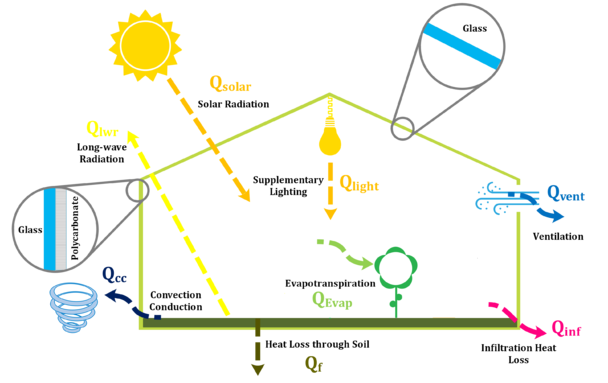Given the relatively stable indoor temperature and humidity in modern commercial greenhouses, they have been treated as a lumped system. Consequently, the first law of thermodynamics, which ensures energy conservation, has been employed to analyze the control volume of the greenhouse. To account for the various heat transfer processes, a balance equation has been applied hourly throughout the day, utilizing available data on solar radiation. Figure 1 presents a schematic representation of the heat sources and sinks within the greenhouse being studied.

 |
Eq. (1) |
|---|
A negative value of 𝑄𝑛𝑒𝑡 indicates a heating requirement, while a positive value represents a cooling demand in the greenhouse. Equation (1) can be expanded as shown below (Eq. (2)) to encompass the following heat transfer processes.
| Eq. (2) |
|---|
where 𝑄𝑠𝑜𝑙𝑎𝑟 represents the heat gained from solar radiation and 𝑄𝑙𝑖𝑔ℎ𝑡 stands for the heat gained from the supplementary lighting system. Additionally, the indices "𝑐𝑐", "𝑎𝑖𝑟𝑒𝑥", "𝑙𝑤𝑟", and "𝑓𝑙𝑜𝑜𝑟" correspond to the thermal losses through conduction and convection from the walls and roof, air exchange, long-wave radiation from the floor, and conduction from the floor, respectively. The term 𝑄𝑒𝑣𝑎𝑝 denotes the thermal loss resulting from plant evapotranspiration. Further details and mathematical equations for each heat transfer mechanism can be found in the article "Energy Modeling and Techno-Economic Feasibility Analysis of Greenhouses for Tomato Cultivation Utilizing the Waste Heat of Cryptocurrency Miners".
How to use the code[edit | edit source]
The thermal model of the greenhouse has been implemented using Matlab and Python, which streamline the calculation processes. To access the codes, please click on the OSF link. For a detailed understanding of how these codes are constructed and how to modify each section to suit your specific applications, you can watch the YouTube video provided below.

